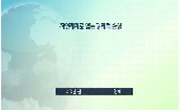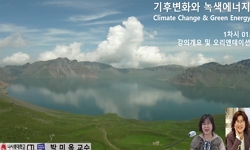According to materials recently published by the Korea Meteorological Administration, the mean temperature rise in the six observation stations in Korea(Seoul, Incheon, Gangneung, Daegu, Mokpo, and Busan) for around 100 years(1912~2008) is 1.7℃, whi...
http://chineseinput.net/에서 pinyin(병음)방식으로 중국어를 변환할 수 있습니다.
변환된 중국어를 복사하여 사용하시면 됩니다.
- 中文 을 입력하시려면 zhongwen을 입력하시고 space를누르시면됩니다.
- 北京 을 입력하시려면 beijing을 입력하시고 space를 누르시면 됩니다.
부가정보
다국어 초록 (Multilingual Abstract)
According to materials recently published by the Korea Meteorological Administration, the mean temperature rise in the six observation stations in Korea(Seoul, Incheon, Gangneung, Daegu, Mokpo, and Busan) for around 100 years(1912~2008) is 1.7℃, which is noticeably higher than 0.74±0.03℃, the global mean temperature rise.
By statistically interpreting and presenting the changes in climate in Gangwon region, this research intended to be used as a basic material in responding to climate change.
In order to do so, this research used the weather datas in the four meteorological observation stations in Gangwon region(Gangneung, Sokcho, Wonju, Hongcheon) for 37 years(1973~2009). Meteorological elements used in their analysis were climate change-related air temperature(mean temperature, maximum temperature, and minimum temperature), precipitation, humidity, and sunshine duration.
In order to be used as a representative value of Gangwon region, each meteorological data was used after calculating the average of observed values at each observation station.
The analysis method was to interpret secular change through the time-series analysis of the annual mean of each element, and simultaneously conducted the five years moving average analysis to filter out the effects of unusual climate.
As a result, while air temperature(annual mean temperature, annual mean maximum temperature, and annual mean minimum temperature), annual precipitation, rainfall factor, and the precipitation concentration of the pluvial period showed a tendency to rise, annual mean humidity, the precipitation concentration of the dry period, annual sunshine duration showed a tendency to fall. The change turned out to be mostly large, the reason for which was that this research used the datas which have been collected since 1973. The 5 year's planning of economic development was conducted from the 1970s to the early 1980s in Korea, and it is highly likely that the result came from the fact that the investigation period coincided with the period. The real analysis showed that temperature change was largest in the 1970s, and that it began to slow down by degrees since then.
On the whole, the change tended to be larger in Youngseo region than in Youngdong region, but the precipitation concentration proved to be more severe in Youngdong region.
목차 (Table of Contents)
- List
- List of table ⅲ
- List of figure ⅳ
- List
- List of table ⅲ
- List of figure ⅳ
- ABSTRACT ⅵ
- 제1장 서론 1
- 제2장 자료선정 및 분석방법 4
- 제1절 자료선정 4
- 제2절 분석방법 5
- 제3장 자료 분석 7
- 제1절 강원지방 7
- 1. 기온 7
- 가. 연평균기온 8
- 나. 연평균최고기온 10
- 다. 연평균최저기온 11
- 2. 강수 12
- 3. 우량인자 13
- 4. 상대습도 14
- 5. 강수집중도 16
- 6. 일조시간 18
- 제2절 영동과 영서지방의 비교 20
- 1. 기온 20
- 가. 연평균기온 20
- 나. 연평균최고기온 23
- 다. 연평균최저기온 25
- 2. 강수 27
- 3. 우량인자 29
- 4. 상대습도 31
- 5. 강수집중도 33
- 6. 일조시간 35
- 제4장 결론 38
- 참고문헌 40
- 참고사이트 40












